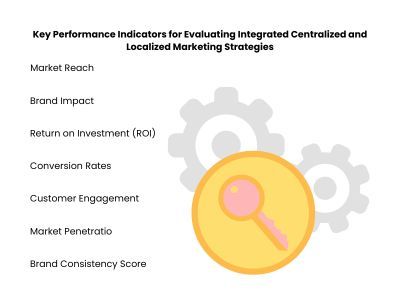Local Marketing
Strategic Harmony: Balancing Central and Local Marketing
Fri, 22 Mar 2024 07:07:13 GMT
Speak to our Hyperlocal Expert

Centralized and localized marketing involves balancing standardized global strategies and tailored campaigns tailor-made for specific regions (localized). This approach ensures a unified brand identity while adapting to the unique needs of different regional markets.
In today's ever-changing global business environment, it's crucial to find the right balance between central and local marketing strategies. As companies expand and serve different markets, achieving harmony between centralized and localized approaches becomes essential. In this article, we explores why this balance is so crucial, highlighting its influence on a brand's impact, market reach, and overall success in the competitive marketing landscape.
Understanding the Role of Centralized and Localized Marketing

In the realm of marketing, both centralized and localized strategies play pivotal roles in shaping a company's approach.
- Understanding Centralized Marketing
Centralized marketing involves creating and implementing standardized strategies on a global scale. It emphasizes consistency in messaging, branding, and campaigns. The central marketing team retains control over key decisions, ensuring a uniform brand image across diverse markets.
- Understanding Localized Marketing
On the other hand, localized marketing tailors strategies to meet the unique demands of specific regions or markets. This approach adapts to cultural nuances, local preferences, and varying market conditions. Localized marketing allows for flexibility and customization to resonate with diverse audiences.
Challenges Faced When Balancing Central and Local Marketing Strategies
Balancing central and local marketing strategies presents several challenges for businesses operating in diverse markets:
1. Cultural Variances
Adapting global campaigns to local cultures can be complex, requiring a deep understanding of customs, language, and societal norms.
2. Coordination and Communication
Ensuring seamless communication and coordination between central and local teams can be challenging, affecting the alignment of overarching strategies.
3. Brand Consistency
Maintaining a consistent brand image across various markets becomes difficult when adapting strategies to meet local preferences and market dynamics.
4. Resource Allocation
Striking the right balance in allocating resources between central and local initiatives requires careful consideration to avoid overemphasis on one at the expense of the other.
5. Regulatory Compliance
Navigating diverse regulatory landscapes in different regions adds complexity, as marketing strategies must comply with varying legal and ethical standards.
6. Data Privacy Concerns
Adhering to different data privacy regulations globally while collecting and utilizing consumer data for marketing purposes is an ongoing challenge.
7. Competing Objectives
Aligning the objectives of central and local teams can be challenging, as conflicting priorities may arise, impacting the overall effectiveness of marketing efforts.
8. Adaptability to Local Markets
Tailoring strategies to suit local market conditions without compromising the essence of centralized plans requires a delicate balance.
9. Technological Integration
Ensuring that technological tools and platforms are seamlessly integrated to support both central and local marketing initiatives poses a technological challenge.
10. Measuring Effectiveness
Establishing uniform metrics to measure the success of both central and local strategies can be challenging due to differing objectives and key performance indicators.
Addressing these challenges requires a strategic approach, clear communication, and a willingness to adapt to the evolving needs of diverse markets.
Centralized and Localized Marketing Strategies
To foster cohesion and effectiveness in marketing across diverse markets, consider implementing the following Centralized and Localized Marketing strategies:
- Centralized Marketing Strategies
a. Brand Consistency
Maintain a uniform brand image across all markets by standardizing messaging, visuals, and campaigns to reinforce a cohesive brand identity.
b. Efficiency in Resource Allocation
Optimize resource distribution by centralizing certain marketing functions, reducing redundancy, and ensuring cost-effectiveness in campaign execution.
c. Global Campaigns
Create and implement marketing campaigns on a global scale, emphasizing universal themes and messaging to reach a broad audience.
d. Streamlined Decision-Making
Centralize decision-making processes to enhance efficiency, coordination, and alignment with overarching organizational goals.
- Localized Marketing Strategies
a. Cultural Adaptation
Tailor marketing strategies to align with local cultures, customs, and preferences, ensuring that campaigns resonate with the specific needs of each region.
b. Language and Communication
Customize messaging in local languages, employing communication styles and tones that resonate with the cultural nuances of specific markets.
c. Regional Campaigns
Develop campaigns that address unique market demands, showcasing an understanding of local trends, preferences, and consumer behaviors.
d. Flexibility in Implementation
Allow for flexibility in executing marketing plans, enabling local teams to adapt strategies based on real-time feedback and changing market dynamics.
The integration of both centralized and localized marketing strategies enables businesses to achieve a harmonious balance, leveraging the strengths of each approach for a comprehensive and effective global marketing strategy.
Optimizing Centralized and Localized Marketing Approaches
- Establishing Clear Communication Channels
Effective communication is foundational for successful coordination between centralized and localized marketing efforts. Establishing clear channels ensures that information flows seamlessly between teams, reducing the likelihood of misunderstandings and promoting a shared understanding of overarching goals.
- Empowering Local Teams without Compromising Brand Consistency
Striking a balance between empowerment and maintaining brand consistency is key. Empowering local teams involves giving them the flexibility to adapt strategies to fit regional needs while adhering to established brand guidelines, ensuring a cohesive brand identity across diverse markets.
- Leveraging Technology for Seamless Integration
In the digital age, technology plays a pivotal role in optimizing marketing approaches. Leveraging advanced tools and platforms facilitates seamless integration between central and local teams. This technological synergy streamlines processes, enhances collaboration, and enables real-time data sharing for more effective and cohesive marketing strategies.
Key Performance Indicators for Evaluating Integrated Centralized and Localized Marketing Strategies
To gauge the success of your strategic harmony between centralized and localized marketing, track key performance indicators (KPIs) that align with your objectives. Consider metrics such as:

1. Market Reach
Measure the expansion of your market reach by tracking the increase in website traffic, social media engagement, and the growth of your customer base in diverse regions.
2. Brand Impact
Assess brand impact through surveys, social media sentiment analysis, and brand recognition studies. Monitor improvements in brand perception and recall among your target audiences.
3. Return on Investment (ROI)
Calculate ROI by comparing the cost of marketing campaigns with the generated revenue. Analyze the profitability of both centralized and localized strategies to ensure a positive return on investment.
4. Conversion Rates
Evaluate conversion rates in different regions to understand the effectiveness of localized campaigns. Track how well each strategy translates into actual customer actions, such as purchases or sign-ups.
5. Customer Engagement
Measure customer engagement through interactions on various channels. Assess the effectiveness of both global and local campaigns in fostering meaningful interactions and relationships with your audience.
6. Market Penetration
Examine the penetration of your products or services in new markets. Evaluate sales growth and market share to determine the success of your strategies in specific regions.
7. Brand Consistency Scores
Implement surveys or tools to assess brand consistency across different markets. Consistency in messaging and brand identity is vital for a unified global presence.
Optimizing Integration Strategies for Centralized and Localized Marketing Efforts
Leveraging technology is pivotal in achieving seamless integration between centralized and localized marketing efforts. Consider employing the following technologies and platforms:
1. Marketing Automation Platforms
Utilize platforms to automate marketing workflows. These tools streamline communication, lead nurturing, and campaign management for both central and local teams.
2. Customer Relationship Management (CRM) Systems
Implement a CRM system to centralize customer data. This ensures that both central and local teams have access to a unified view of customer interactions and preferences.
3. Collaboration Tools
Platforms facilitate seamless communication and coordination between central and local teams. These tools enhance collaboration and streamline decision-making processes.
4. Data Analytics and Business Intelligence Tools
Leverage tools to gather insights into the performance of marketing campaigns. Analyzing data helps in making informed decisions and refining strategies.
5. Content Management Systems (CMS)
Implement a robust CMS to centrally manage and distribute marketing content. This ensures consistent messaging while allowing local teams to customize content for specific markets.
6. Localization Platforms
Use localization tools to adapt content for different languages and cultural nuances. This ensures that marketing materials resonate effectively with diverse audiences.
7. Unified Communication Platforms
Implement platforms for Business, or Microsoft Teams for virtual meetings and real-time communication. These tools enhance collaboration between teams operating in different regions.
By incorporating these technologies, businesses can establish a technologically integrated ecosystem that supports both central and local marketing initiatives, fostering efficiency, collaboration, and successful campaign execution.
Frequently Asked Questions (FAQs)
1. What is a Centralized Marketing Strategy?
A centralized marketing strategy involves creating and implementing standardized marketing plans on a global scale, maintaining a consistent brand image and messaging across all markets.
2. What is a Localized Marketing Strategy?
A localized marketing strategy tailors marketing efforts to specific regions or markets, adapting campaigns to local cultural nuances, preferences, and market conditions for more targeted and effective outreach.
3. Why is Localised Marketing Important?
Localized marketing is crucial as it allows businesses to connect with diverse audiences by addressing cultural differences, tailoring messages, and meeting specific regional needs, thereby enhancing brand relevance and resonance.
4. What is a Centralized Marketing Approach?
A centralized marketing approach involves making key marketing decisions from a central point within the organization, ensuring a consistent strategy across all markets.
5. What is Global Advertising and Local Advertising?
Global advertising encompasses campaigns designed for a worldwide audience, emphasizing universal themes, while local advertising tailors messages to specific markets, considering local culture, language, and consumer behaviors for more targeted and personalized outreach.
Conclusion
In conclusion, achieving strategic harmony between central and local marketing is paramount for businesses seeking global success. By striking the right balance, companies can harness the strengths of centralized and localized marketing strategies, ensuring a cohesive brand identity while adapting to diverse market needs. The collaborative approach discussed in this article provides a roadmap for businesses to navigate the complexities of the global marketplace, fostering sustained growth and resonance.
Take Advantage of Sekel Tech’s Platform
For businesses aiming to streamline their central and local marketing efforts, Sekel Tech’s advanced platform offers a comprehensive solution. With features designed for seamless communication, efficient data management, and collaborative campaign execution, Sekel Tech empowers organizations to achieve optimal synergy between centralized and localized marketing strategies. Elevate your marketing game and embrace a harmonious approach with Sekel Tech’s innovative platform.
Share
Similar Blogs
Loved this content?
Sign up for our newsletter and get the latest tips & updates directly in your inbox.
There’s more where that came from!